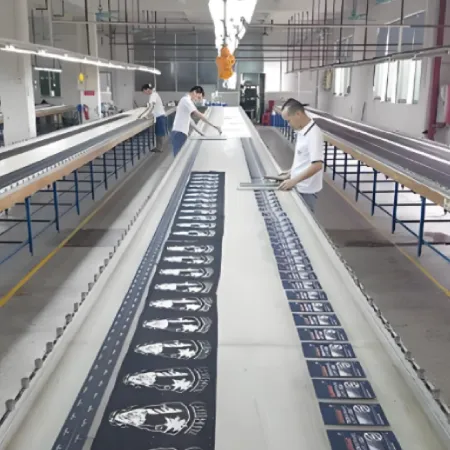Cuando se trata de etiquetas personalizadas, pocos métodos de impresión ofrecen la misma calidad y durabilidad que serigrafíaYa sea que diseñe etiquetas para ropa, empaques o artículos promocionales, comprender el proceso de serigrafía y cómo elegir entre métodos manuales y mecánicos es esencial. En este artículo, analizaremos en detalle los dos tipos principales de... serigrafía Técnicas: impresión automática (a máquina) e impresión manual (con mesa móvil). Exploraremos sus diferencias, beneficios, desafíos y cómo seleccionar el método adecuado para su proyecto.

¿Qué es la serigrafía?
SerigrafíaTambién conocida como serigrafía, es una técnica que se utiliza para transferir tinta a un material mediante una malla. La malla se prepara con una plantilla que bloquea las zonas donde no se desea tinta, permitiendo que esta pase solo por las zonas abiertas para formar un diseño. Este método es popular para crear diseños vibrantes, duraderos y de alta calidad. etiquetas serigrafiadas personalizadas sobre diversas superficies como tela, plástico y metal.
La principal ventaja de serigrafía Es la capacidad de producir diseños altamente detallados y saturados, lo que la hace perfecta para branding, logotipos y obras de arte complejas. A diferencia de la impresión digital, que puede desteñirse o desgastarse con el tiempo, la serigrafía se caracteriza por sus resultados duraderos y colores vibrantes.
Serigrafía a máquina vs. manual
Hay dos métodos principales para crear serigrafíasImpresión a máquina e impresión manual. Ambas tienen sus ventajas únicas, pero la elección depende en gran medida del tamaño del pedido y de los requisitos específicos del diseño.
1. Serigrafía a máquina (automática)
Serigrafía a máquina Utiliza equipos automatizados para producir etiquetas a alta velocidad y con resultados consistentes. El proceso de impresión es eficiente, con capas de tinta que se suelen aplicar de 1 a 3 veces, lo que resulta en un efecto visual relativamente sutil. Este método es ideal para producciones de gran volumen de diseños sencillos con poca variación de color.
Ventajas de la serigrafía a máquina:
- Producción de alto volumen:Perfecto para grandes tiradas de etiquetas que requieren uniformidad y velocidad.
- Consistencia:La impresión a máquina garantiza que cada etiqueta sea idéntica en términos de color, diseño y calidad.
- Rentable para pedidos al por mayorCuanto más imprima, más barato será el coste por etiqueta, lo que lo hace ideal para la producción en masa.
Sin embargo, la impresión a máquina tiene sus limitaciones. Puede no ser ideal para etiquetas con diseños intrincados, múltiples colores o detalles finos, ya que la calidad de impresión puede carecer de la nitidez y profundidad que se logran con los métodos manuales.

2. Serigrafía manual (Walk-Table)
Serigrafía manual Implica que los artesanos usen sus manos para guiar la malla y presionar la tinta sobre el material. Este método es más lento que la impresión a máquina, pero ofrece mayor control sobre la precisión del diseño, las capas de tinta y los efectos visuales.
Ventajas de la serigrafía manual:
- Mayor flexibilidad de diseño:Los artistas pueden ajustar el grosor, la alineación y la ubicación del diseño para satisfacer necesidades específicas.
- Mejor profundidad visual y texturaLa impresión manual permite un control más preciso sobre la saturación del color, lo que puede dar como resultado acabados de mayor calidad que lucen más lujosos.
- Ideal para diseños complejos o de lotes pequeños.:Si el diseño de su etiqueta incluye degradados, combinaciones de varios colores o texto pequeño, la impresión manual es la mejor opción.
A pesar de su calidad superior, la impresión manual requiere un artesano experto y el proceso es laborioso. El tiempo de producción puede variar según la complejidad del diseño y la cantidad de etiquetas producidas.

Calidad de la impresión serigráfica: ¿Qué la afecta?
Ya sea que elija la impresión a máquina o manual, hay varios factores que pueden afectar el resultado general. calidad de serigrafía de tus etiquetas:
- MaterialEl tipo de material sobre el que se imprime influye significativamente en el resultado. Las telas, los plásticos y los metales reaccionan de forma diferente a la tinta, y el método de impresión utilizado dependerá de las características del material.
- Calidad de la tintaUsar el tipo de tinta adecuado es esencial para lograr impresiones vibrantes y duraderas. Diferentes tipos de tinta, como el plastisol o las tintas a base de agua, son adecuados para distintos materiales y aplicaciones.
- Calidad de la malla:La malla de malla utilizada en el serigrafía El proceso debe ser meticuloso y estar bien mantenido. Una pantalla de mala calidad o dañada dará como resultado impresiones borrosas o inconsistentes.
- Design ComplexityCuanto más complejo sea el diseño, más difícil será lograr resultados de alta calidad, especialmente con la impresión a máquina. Las líneas finas, los degradados y el texto pequeño suelen requerir intervención manual para mantener la claridad.
Para garantizar impresiones de alta calidad, es fundamental colaborar estrechamente con su socio de impresión. Proporcionarle archivos de diseño claros, especificar el tipo de material y tinta necesarios y acordar el plazo de producción ayudará a evitar malentendidos y a garantizar que el producto final cumpla con sus expectativas.
Cuándo elegir serigrafía manual o a máquina
La decisión de optar por la serigrafía a máquina o manual depende de varios factores, como la escala de producción, la complejidad del diseño y el acabado deseado. Aquí tienes una guía sencilla:
- Para producción a gran escala con diseños sencillos:Si está produciendo grandes cantidades de etiquetas con diseños simples (por ejemplo, texto negro sobre fondo blanco), serigrafía a máquina es la opción más rentable y eficiente.
- Para lotes pequeños o diseños complejos:Si necesita un lote pequeño de etiquetas con diseños intrincados, efectos de color especiales o degradados, serigrafía manual Es la mejor opción. Este método ofrece mayor flexibilidad y los resultados suelen ser superiores en calidad y detalle.
Conclusión: Cómo elegir el método de serigrafía adecuado
In conclusion, serigrafía Es un método versátil y fiable para crear etiquetas personalizadas de alta calidad. Tanto si opta por la impresión a máquina para producciones a gran escala como por la impresión manual para lotes más pequeños con diseños complejos, es fundamental comprender las ventajas y limitaciones de cada método. Al considerar factores como la complejidad del diseño, el volumen de producción y el acabado deseado, podrá elegir el mejor enfoque para su proyecto.
Al trabajar con serigrafíaColaboramos siempre con profesionales experimentados para garantizar resultados de la más alta calidad. Ya sea que cree etiquetas para ropa, empaques o artículos promocionales, la elección correcta del método de impresión garantizará que su diseño destaque y dure años.


